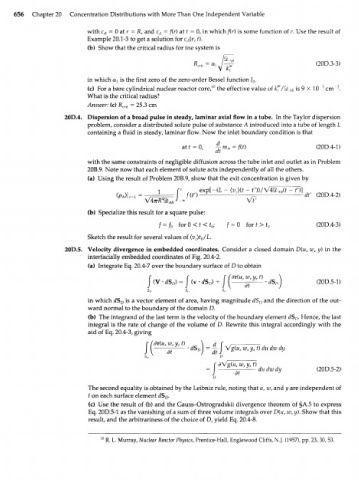Page 676 - Bird R.B. Transport phenomena
P. 676
656 Chapter 20 Concentration Distributions with More Than One Independent Variable
with c A = 0 at r = R, and c A = f(r) at t = 0, in which /(r) is some function of r. Use the result of
Example 20.1-3 to get a solution for c (r, t).
A
(b) Show that the critical radius for tne system is
^ (20D.3-3)
in which a is the first zero of the zero-order Bessel function / .
} 0
2
10
r
(c) For a bare cylindrical nuclear reactor core, the effective value of k" / d is 9 X 10 ' cm" .
AVt
What is the critical radius?
Answer: (c) R crit = 25.3 cm
20D.4. Dispersion of a broad pulse in steady, laminar axial flow in a tube. In the Taylor dispersion
problem, consider a distributed solute pulse of substance A introduced into a tube of length L
containing a fluid in steady, laminar flow. Now the inlet boundary condition is that
atf = O, j-m =f(t) (20D.4-1)
A
with the same constraints of negligible diffusion across the tube inlet and outlet as in Problem
20B.9. Note now that each element of solute acts independently of all the others.
(a) Using the result of Problem 20B.9, show that the exit concentration is given by
exp[-(L - (v,)(t - f'))/V43> (f - f')l
1/4 F 4B
—dt' (20D.4-2)
(b) Specialize this result for a square pulse:
t
/ = / for 0 < t < ; / = 0 for t > t (20D.4-3)
0 0 0
Sketch the result for several values of (v )t /L.
z 0
20D.5. Velocity divergence in embedded coordinates. Consider a closed domain D{u, w, y) in the
interfacially embedded coordinates of Fig. 20.4-2.
(a) Integrate Eq. 20.4-7 over the boundary surface of D to obtain
f f f (Mu, w, y, t) \
J (V • rfS ) = J (v • dS ) + J ( -r^— • dS J (20D.5-1)
D D
in which dS D is a vector element of area, having magnitude dS D and the direction of the out-
ward normal to the boundary of the domain D.
(b) The integrand of the last term is the velocity of the boundary element dS . Hence, the last
D
integral is the rate of change of the volume of D. Rewrite this integral accordingly with the
aid of Eq. 20.4-3, giving
(дт(и, w, y, t)
at dS D \ = — I y/g(u, iv, y, t) du dw dy
= J f d\/v(u, w, y, t) du dwdy (20D.5-2)
—
..
The second equality is obtained by the Leibniz rule, noting that u, w, and у are independent of
t on each surface element dS .
D
(c) Use the result of (b) and the Gauss-Ostrogradskii divergence theorem of §A.5 to express
Eq. 20D.5-1 as the vanishing of a sum of three volume integrals over D(u, w, y). Show that this
result, and the arbitrariness of the choice of D, yield Eq. 20.4-8.
10 R. L Murray, Nuclear Reactor Physics, Prentice-Hall, Englewood Cliffs, N.J. (1957), pp. 23, 30, 53.

